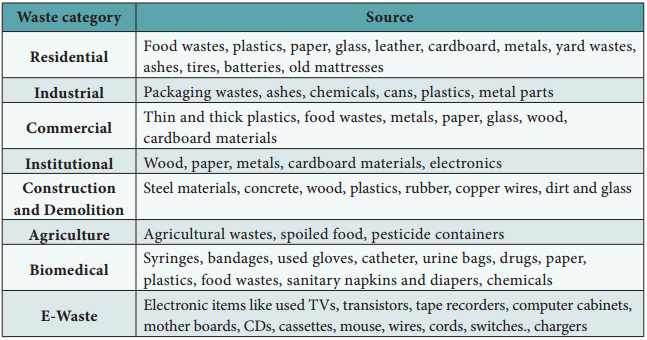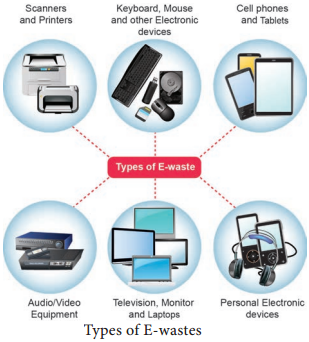Learninsta presents the core concepts of Biology with high-quality research papers and topical review articles.
Solid Waste Management
Every day, tonnes of solid wastes are disposed off at landfill sites. This waste comes from homes, offices, industries and various other agricultural related activities. These landfill sites produce foul smell if waste is not stored and treated properly.
When hazardous wastes like pesticides, batteries containing lead, cadmium, mercury or zinc, cleaning solvents, radioactive materials, e-waste and plastics are mixed up with paper and other scraps and burnt, they produce gases such as dioxins. These gases are toxic and carcinogenic. These pollute the surrounding air, ground water and can seriously affect the health of humans, wildlife and our environment (Table 12.1).

Solid Waste management includes the activities and actions required to manage waste from its inception to its final disposal. This includes the collection, transport, treatment and disposal of waste, together with monitoring and regulation of the waste management process. It is all about how solid waste can be changed and used as a valuable resource.
Case Study:
The Corporation of Chennai looks after clearance and management of solid waste in Chennai. Every day around 5400 Metric Tonnes (MT) of garbage is collected from the city. Door to door collection of garbage is done in most zones apart from sweeping, collecting, and storing the waste in the specified bins.
At present garbage generated in Chennai is dumped at two sites. Proposals are there for remediation of the existing landfill or scientific closure and to have integrated waste processing facilities with waste to energy plants as one of the components at the existing Kodungaiyur and Perungudi sites.
Waste Management Practices
- Source segregation
- Composting
- Aerobic
- Anaerobic
- Vermicomposting
- Biogas generation
- Incineration
Radioactive Waste
Radioactive wastes are generated during various operations of the nuclear power plant. Radioactive waste can be in gas, liquid or solid form, and its level of radioactivity can vary. The waste can remain radioactive for a few hours or several months or even hundreds of thousands of years. Depending on the level and nature of radioactivity, radioactive wastes can be classified as exempt waste, Low and Intermediate level waste and High Level Waste.
Radioactive Waste Management
Radioactive waste management involves the treatment, storage, and disposal of liquid, airborne, and solid effluents from the nuclear industry.
Methods of Disposal of Radioactive Wastes are
1. Limit Generation:
Limiting the generation of waste is the first and most important consideration in managing radioactive wastes.
2. Dilute and Disperse:
For wastes having low radioactivity, dilution and dispersion are adopted.
3. Delay and Decay:
Delay and decay is frequently an important strategy because much of the radioactivity in nuclear reactors and accelerators is very short lived.
4. Concentrate and Confie Process:
Concentrating and containing is the objective of treatment activities for longerlived radioactivity. The waste is contained in corrosion resistant containers and transported to disposal sites. Leaching of heavy metals and radionuclides from these sites is a problem of growing concern.
Control and Management
Three ways are employed to manage nuclear wastes.
Spent Fuel Pools:
The spent fuel discharged from the reactors is temporarily stored in the reactor pool. The Spent fuel rods are used in stored cooling ponds. They protect the surroundings from radiation and absorb the heat generated during radioactive decay.
Vitrification Method:
This prevents reaction or degradation of nuclear waste for extended periods of time and encased in dry cement caskets.
Geological Repositories:
A deep geological repository is a nuclear waste repository excavated deep within a stable geologic environment. It is suited to provide a high level of long-term isolation and containment without future maintenance. In India at Tarapur and Kalpakkam, a wet storage facility of Spent Fuel is the main mode of storage.
Medical Waste
Any kind of waste that contains infectious material generated by hospitals, laboratories, medical research centers, Pharmaceutical companies and Veterinary clinics are called medical wastes.
Medical wastes contain body fluids like blood, urine, body parts and other contaminants, culture dishes, glasswares, bandages, gloves, discarded needles, scalpels, swabs and tissues.
Management:
The safe and sustainable management of biomedical waste is the social and legal responsibilities of people working in healthcare centers.
Waste Disposal:
Involved by incineration, chemical disinfection, autoclaving, encapsulation, microwave irradiation are methods of waste disposals. Final disposal includes landfill and burying as per norms inside premises.
E-Waste
Electronic waste or e-waste describes discarded electrical electronic devices as well as any refuse created by discarded electronic devices and components and substances involved in their manufacture or use. Their disposal is a growing problem because electronic equipment frequently contains hazardous substances.
In a personal computer, for example, there may be lead (Pb) in the cathode ray tube (CRT) and soldering compound, mercury (Hg) in switches and housing, and cobalt (Co) in steel components, among other equally
toxic substances. E-wastes are basically PCB (Polychlorinated biphenyl) based, which are non-degradable (Fig.12.8).

Used electronics which are destined for reuse, resale, salvage, recycling, or disposal are also considered e-waste. Unauthorised processing of e-waste in developing countries can lead to adverse human health effects and environmental pollution.
Recycling and disposal of e-waste may involve significant risk to the health of workers and communities in developed countries and great care must be taken to avoid unsafe exposure in recycling operations and leaking of materials such as heavy metals from landfills and incinerator ashes.
Plastic Waste – Solutions and Remedies
Plastics are low molecular weight organic polymers that are non-degradable in the natural environment. They are used in several items, including cars, bulletproof vests, toys, hospital equipment, carry bags and food containers.
Packaging materials used in supermarkets, retail outlets, manufacturing industries, households, hotels, hospitals, restaurants and transport companies are major contributors to plastic waste generation. Plastic waste constitutes a major part of municipal solid waste.